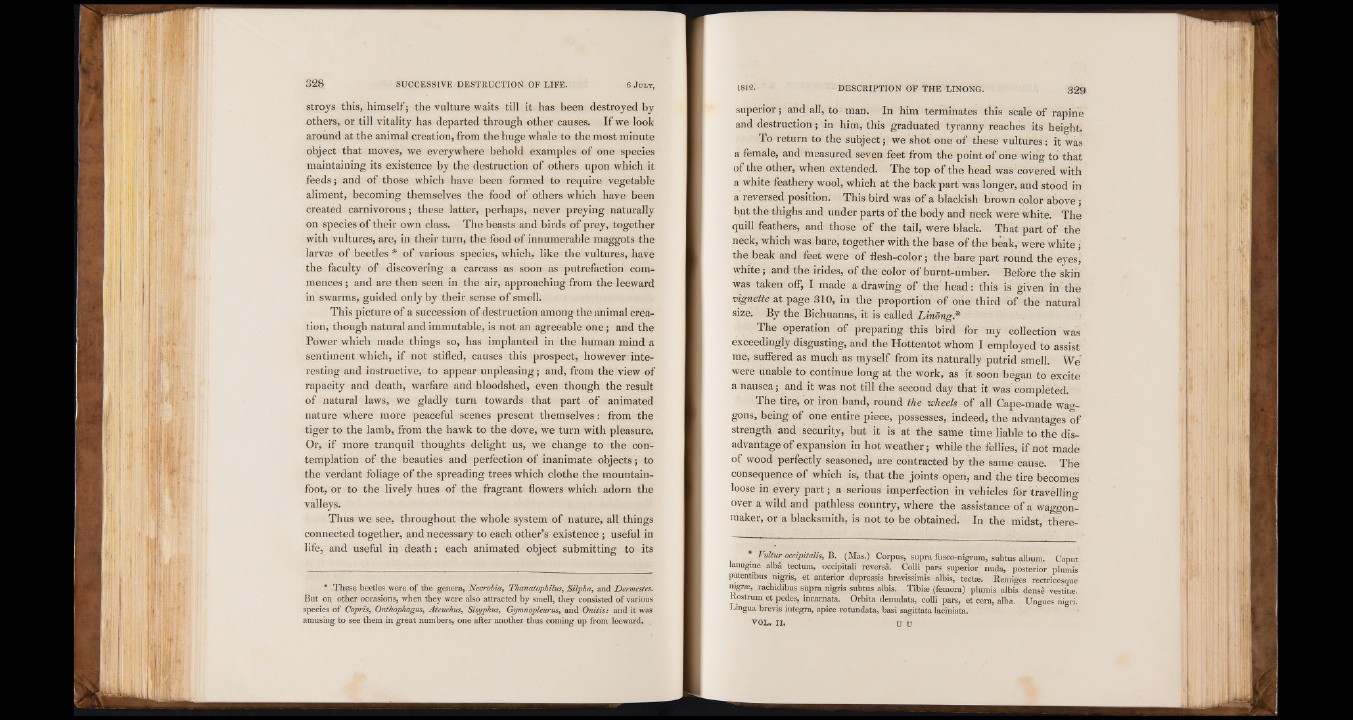
stroys this, himself; the vulture waits till it has been destroyed by
others, or till vitality has departed through other causes. If we look
around at the animal creation, from the huge whale to the most minute
object that moves, we everywhere behold examples of one species
maintaining its existence by the destruction of others upon which it
feeds; and of those which have been formed to require vegetable
aliment, becoming themselves the food of others which have been
created carnivorous; these latter, perhaps, never preying naturally
on species of their own class. The beasts and birds of prey, together
with vultures, are, in their turn, the food of innumerable maggots the
larvse of beetles * of various species, which, like the vultures, have
the faculty of discovering a carcass as soon as putrefaction commences
; and are then seen in the air, approaching from the leeward
in swarms, guided only by their sense of smell.
This picture of a succession of destruction among the animal creation,
though natural and immutable, is not an agreeable one; and the
Power which made things so, has implanted in the human mind a
sentiment which, if not stifled, causes this prospect, however interesting
and instructive, to appear unpleasing; and, from the view of
rapacity and death, warfare and bloodshed, even though the result
of natural laws, we gladly turn towards that part of animated
nature where more peaceful scenes present themselves: from the
tiger to the lamb, from the hawk to the dove, we turn with pleasure.
Or, if more tranquil thoughts delight us, we change to the contemplation
of the beauties and perfection of inanimate objects; to
the verdant foliage of the spreading trees which clothe the mountain-
foot, or to the lively hues of the fragrant flowers which adorn the
valleys.
Thus we see, throughout the whole system of nature, all things
connected together, and necessary to each other’s existence ; useful in
life, and useful ip death: each animated object submitting to its
* These beetles were of the genera, Necrobia, Thanatophilus, Silpha, and Dermestes.
But on other occasions, when they were also attracted by smell, they consisted of various
species of Cqpris, Onthophagus, Ateuchm, Sisyphus, Gymuop/eurus, and Onitis: and it was
amusing to see them in great numbers, one after another thus coming up from leeward.
superior; and all, to man. In him terminates this scale of rapine
and destruction; in him, this graduated tyranny reaches its height.
To return to the subject; we shot one of these vultures: it was
a female, and measured seven feet from the point of one wing to that
of the other, when extended. The top of the head was covered with
a white feathery wool, which at the back part was longer, and stood in
a reversed position. This bird was of a blackish brown color above;
but the thighs and under parts of the body and neck were white. The
quill feathers, and those of the tail, were black. That part of the
neck, which was- bare, together with the base of the beak, were white;
the beak and feet were of flesh-color; the bare part round the eyes,
white; and the irides, of the color of burnt-umber. Before the skin
was taken off, I made a drawing of the head: this is given in the
vignette at page 310, in the proportion of one third of the natural
size.. By the Bichuanas, it is called Linong.*
The operation of preparing this bird for my collection was
exceedingly disgusting, and the Hottentot whom I employed to assist
me, suffered as much as myself from its naturally putrid smell. We
were unable to continue long at the work, as it soon began to excite
a nausea; and it was not till the second day that it was'completed.
The tire, or iron band, round the wheels of all Cape-made waggons,
being of one entire piece, possesses, indeed, the advantages of
strength and security, but it is at the same time liable to the disadvantage
of expansion in hot weather; while the fellies, if not made
of wood perfectly seasoned, are contracted by the same cause. The
consequence of which is, that the joints open, and the tire becomes
loose in every part; a serious imperfection in vehicles for travelling
over a wild and pathless country, where the assistance of a waggon-
maker, or a blacksmith, is not to be obtained. In the midst, ther'e-
* VuUur occipitalis, B. (Mas.) Corpus, supra fusco-nigrum, subtus album. Caput
lanugine alba tectum, occipitali reversà. Colli pars superior nuda, posterior plumis
patentibus nigris, et anterior depressis brevissimis albis, tectse. Remiges rectricesqufe
nigra, rachidibus supra nigris subtus albis. Tibiaj (femora) plumis albis densè vestita:.
Rostrum et pedes, incarnata. Orbita denudata, colli pars, et cera, alba. Ungues nigri.
Lingua brevis integra, apice rotondata, basi sagittata laciniata.